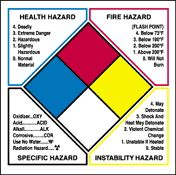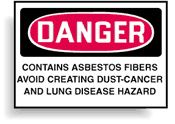 |
 |
| MSDS Topics |
Free Sites | FAQ's | Regulations | Glossary | Software | Suppliers |
| Books | Forum | Poll | Fun stuff | Quiz | Store | |
| MSDS and safety supplies | Search ALL our MSDS info | |||||
 | |||
 |
 |
 |
|
| Title: 07/26/1989 - Labeling requirements of the Hazard Communication Standard. | |
| Record Type: Interpretation | Standard Number: 1910.1200(f) |
July 26, 1989
The Honorable Robert W. Kasten, Jr.
United States, Senate
Washington, D.C. 20510
Dear Senator Kasten:
|
This is in response to your correspondence of June 27, addressed to Ruth Knight, Director of Intra-governmental Affairs, on behalf of your constituent, Ernest E. McClellan of Plast-O-Meric, Inc., regarding the label requirements of the Occupational Safety and Health Administration's (OSHA) Hazard Communication Standard (HCS), 29 CFR 1910.1200. The HCS requires shipped containers of hazardous chemicals to be labeled, tagged or marked with the identity of the hazardous chemicals, appropriate hazard warnings, and the name and address of the chemical manufacturer, importer, or other responsible party. Plast-O-Meric, Inc. was issued a citation for not providing appropriate hazard warnings on its containers of hazardous chemicals which are shipped to downstream employers. An in-plant labeling system was used as labels for their shipped containers, which did not include appropriate health hazard information including the target organ effects. |  Communicate workplace hazards with handy labels from Safety Emporium. |
OSHA does allow the use of standardized in-plant labeling systems for containers of hazardous chemicals which do not leave the workplace. These labels, incorporating rating systems, often contain less detailed information on the chemical hazards than is required by the rule. However, when these labels are used in conjunction with material safety data sheets (MSDSs) which provide the required detailed information and training, as required by the standard, they are permitted for in-plant containers. In-plant labeling systems are not permitted for shipped containers unless the required label information is affixed to the container. Shipped container labels may provide the" only hazard information in certain situations and there is no guarantee that downstream employees handling or using the chemicals will be able to understand the less detailed information permitted on in-plant labels.
Regarding Mr. McClellan's concern about the coverage of hazardous chemicals physically bound in a material, the standard does not cover hazardous chemicals when the material is bound in such a way that employees cannot be exposed. If there is no exposure, either under normal conditions of use or in a foreseeable emergency, then the chemical is not covered by the standard, and the hazard information for the chemical would not be required on the label. However, if under normal conditions of use, an action is performed downstream on the product that could release the hazardous chemical, then the substance would be covered under the HCS and the provisions of the standard would apply.
|
Mr. McClellan also stated that he is not receiving hazard information from his suppliers. Chemical manufacturers and importers are required to evaluate the hazards of the chemicals they produce or import and to convey the hazard information to downstream employers and distributors in the form of labels and MSDSs If the information Mr. McClellan receives from his suppliers is deficient, he should write to both the product manufacturer and supplier for corrected labels or sheets. In the event he does not receive the corrected information, Mr. McClellan should send copies of the deficient items to his nearest OSHA Area Office and request assistance in obtaining properly completed labels and MSDSs. Mr. McClellan is also concerned that all chemical manufacturers be required to comply with the HCS requirements. OSHA would like to point out that all chemical manufacturers and importers have been required to label shipped containers of hazardous chemicals with the appropriate hazard information since November 25, 1985. We hope this information is helpful to you in responding to your constituent's concerns. Please feel free to contact us again if further assistance is needed. |  Ensure that your MSDS collection is "readily accessible" with these handy compliance centers from Safety Emporium.
|
Alan C. McMillan
Acting Assistant Secretary
DATE: November 23, 1988
REPLY TO ATTN OF: William A. Thomas, Area Director
SUBJECT: Asbestos Construction Standard, 1926.58
Thru: Michael G. Connors, Acting ARA/Technical Support
We have recently been reviewing the construction asbestos standard, enforcement directive and policy letters in detail, and would appreciate your thoughts on enforcement policy in the following areas:
|  If you have an asbestos hazard, good signage and labeling are critical. Signs from Safety Emporium can help.
Supplied air respirator systems like this one from Safety Emporium are critically important when working with asbestos. |
Ms. Ruth Knight
Director of Intergovernmental Affairs
Occupational Safety & Health Administration
200 Constitution Avenue, N.W. - N3641
Washington, D.C. 20210
Dear Ms. Knight:
Please find enclosed correspondence I received from Ernest McClellan. Because of my desire to be responsive to the constituents in my state, I am referring this matter to you for your review.
I would like to request your assistance in evaluating the information provided. I would greatly appreciate your forwarding your findings in duplicate form to David Edwards, on my staff, at your earliest convenience.
Again, many thanks for your time and attention to this matter.
Best regards,
Robert W. Kasten, Jr.
Enclosure
May 1, 1989
Senator Robert W. Kasten, Jr.
110 Hart Senate Office Bldg.
Washington, DC 20510
Dear Senator Kasten:
Our company faces a situation that could do it irreparable harm. As a result of an employee complaint, an OSHA inspection was made at our Ohio plant. We were not cited for the complaint, but were cited for improper labeling on the containers that we ship to customers. Reference to this citation is issuance date 2-21-89, inspection number 103058236, responding ID 0524700, CSHO [Compliance Safety and Health Officer] ID C5828, optional report number 264, Toledo, Ohio office.
The hazard Communication Standard, 29 CFR 1910.1200 mandates use of a warning label on containers (29 CFR 1910.1200(f)(1) (2) (3) along with other information. See Exhibit 1.
In OSHA Instruction CPL 2-2.38A, May 16, 1986 (a bulletin furnished to OSHA Inspectors), an interpretation of the labeling requirements is made. See Exhibit 2.
Our dilemma is:
|
OSHA's approach to their interpretation of labeling requirements is akin to having a 20 MPH unposted speed limit between two 65 MPH signs, and then relying upon traffic officers to inform offenders. Why not amend 29 CFR 1910.1200, publish it, and then set a date for enforcement? We hope that there is some way that you can help us out of this dilemma. We would gladly comply if we knew that all must comply at the same time. Otherwise, as of May 24, 1989, many of Plast-O-Meric's customers will look upon us as the irresponsible supplier of toxic materials. If, at a later date, the OSHA interpretation is challenged and rescinded, we'll look even worse. Yours sincerely,
Ernest E. McClellan |  Teach your employees about MSDS's with posters and pamphlets from Safety Emporium. |
Exhibit 1 - 29 CFR 1910.1200(f)(1)(ii) - Appropriate hazard warnings; and (iii) - Name and address of the chemical manufacturer, importer, or other responsible party.
Exhibit 2 - OSHA Instruction CPL 2-2.38A CH-1, Jul 18,1986 (f)(1) (in part) - Consequently for shipped containers the "hazard warning" must convey the hazard of the chemical. This is intended to be specific information regarding the hazard. The specific hazards indicated in the standard's definitions for "physical" and "health" hazards would be appropriate. Phrases such as "caution", "danger", or "harmful if inhaled", are not adequate warnings for shipped containers since the availability of MSDS and the standards training requirements only apply to a limited number of establishments that will be receiving hazardous chemicals. The definition of "hazard warning" states that the warning must convey the hazard of the chemical. If, when inhaled, the chemical causes lung damage, then that is the appropriate warning. Lung damage is the hazard, not inhalation. There are some situations where the specific target organ effect is not known. Where this is the case, the more general warning statement would be permitted. For example, if the only information available is an LC50 test result, "harmful if inhaled" may be appropriate.
Exhibit 3 -
April 12, 1989
Ernest E. McClellan
Plast-O-Meric
W227 N6225
Sussex Road
P.O. Box 146
Sussex, Wisconsin 53089-0146
Re: Labeling Requirements
Dear Ernie:
|
As we discussed last week, OSHA requires manufacturers of hazardous substances to list the hazards of the chemical, including the target organ effects, on the container label. OSHA has specifically stated that phrases such as "caution", "danger", or "harmful if inhaled" are not sufficient. For example, if a chemical causes lung damage if inhaled, then the appropriate warning should be that the chemical causes lung damage if inhaled. A warning of "harmful if inhaled" will not be enough. OSHA's requirement that manufacturers specifically state the target organ effects on labels of hazardous substances is nowhere to be found in the formal OSHA regulations. OSHA claims that this rule is a logical interpretation of its formal labeling regulations. Some reasonable people disagree. As you know, OSHA is enforcing this interpretation and it has cited seversl companies for violating this standard. On at least four occasions, cited companies have challenged the labeling requirement alleging that it is invalid because the proper rulemaking procedures were not followed. Unfortunately, each of those citations was settled with OSHA before the issue of the validity of the regulations was decided. As it stands now, OSHA requires the labels to state the hazards of the chemical, including target organ effects. I would imagine that this regulation will be challenged again and I will keep you informed of any favorable developments. |  Safety Emporium has OSHA-compliant target organ labels and much more! |
Sincerely,
QUARLES & BRADY
James T. Lucke
The official, public domain, OSHA version of this document is available at http://www.osha.gov/pls/oshaweb/owadisp.show_document?p_table=INTERPRETATIONS&p_id=19836&p_text_version=FALSE